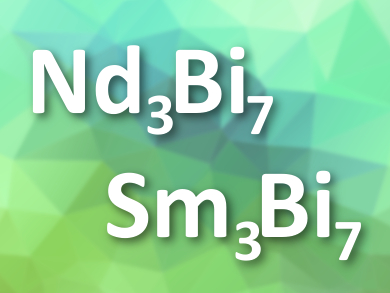Compounds of rare earth elements and group 15 elements often have useful properties and could be used, e.g., as magnetic or thermoelectric materials. There are many known rare-earth nitrides, phosphides, arsenides, and antimonides. However, since bismuth has a metallic character, the corresponding bismuthides do not crystallize as easily. Thus, many Bi analogues of the lighter group 15 compounds have not been found so far. The phase diagrams of binary rare-earth bismuthides, for example, had been studied fairly well, but, as it turns out, they were not complete.
Svilen Bobev and colleagues, University of Delaware, Newark, USA, have discovered two binary rare-earth bismuthides which had been missing from the respective phase diagrams until now, namely, Nd3Bi7 and Sm3Bi7. The compounds were first observed as side products while the researchers were studying more complex bismuthides. They then prepared pure samples by mixing the respective elements in the required stoichiometric ratio and annealing the mixtures in a vacuum at 450 °C for a total of 18 days. The team was also able to prepare crystals of both compounds, which were characterized using X-ray diffraction measurements.
Both compounds crystallize in the space group Immm. The crystal structures are fairly complex and include many Bi–Bi interactions. The team’s attempts to synthesize compounds of the type M3Bi7 with other rare-earth metals (M = La–Pr, Eu, Gd) failed. According to the researchers, this might be due to the fact that the size of other rare earth elements is incompatible with the crystal structure of the synthesized compounds. The researchers performed calorimetric measurements on Nd3Bi7 and Sm3Bi7 and found that both compounds decompose above ~500 °C. This could explain why they had not been found earlier.
- Yet again, new compounds found in systems with known binary phase diagrams. Synthesis, crystal and electronic structure of Nd3Bi7 and Sm3Bi7,
Alexander Ovchinnikov, Julien P A Makomgo, Svilen Bobev,
Chem. Commun. 2018.
https://doi.org/10.1039/c8cc02563k




